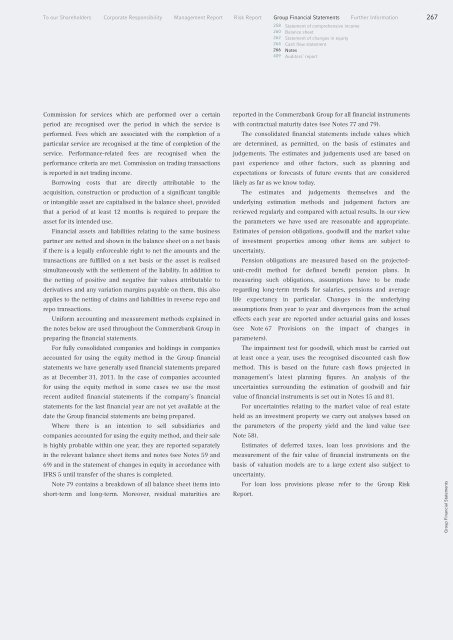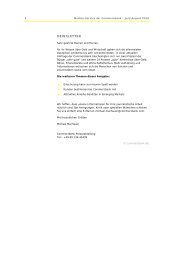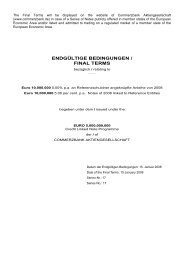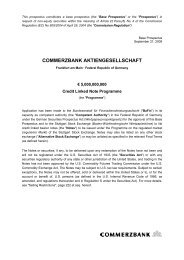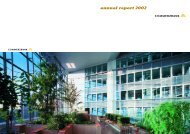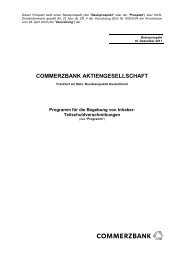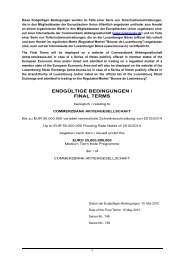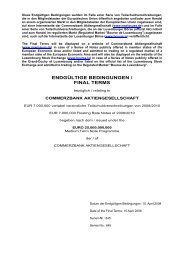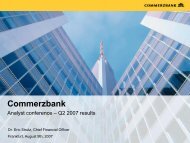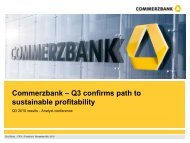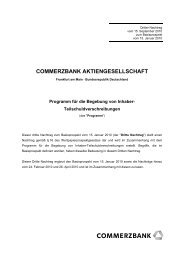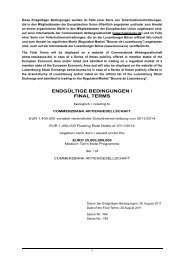COMMERZBANK AKTIENGESELLSCHAFT
COMMERZBANK AKTIENGESELLSCHAFT
COMMERZBANK AKTIENGESELLSCHAFT
Create successful ePaper yourself
Turn your PDF publications into a flip-book with our unique Google optimized e-Paper software.
To our Shareholders Corporate Responsibility Management Report Risk Report Group Financial Statements Further Information 211 267<br />
258 202 Statement of comprehensive income<br />
260 204 Balance sheet<br />
262 206 Statement of changes in equity<br />
264 208 Cash flow statement<br />
266 210 Notes<br />
409 353 Auditors’ report<br />
Commission for services which are performed over a certain<br />
period are recognised over the period in which the service is<br />
performed. Fees which are associated with the completion of a<br />
particular service are recognised at the time of completion of the<br />
service. Performance-related fees are recognised when the<br />
performance criteria are met. Commission on trading transactions<br />
is reported in net trading income.<br />
Borrowing costs that are directly attributable to the<br />
acquisition, construction or production of a significant tangible<br />
or intangible asset are capitalised in the balance sheet, provided<br />
that a period of at least 12 months is required to prepare the<br />
asset for its intended use.<br />
Financial assets and liabilities relating to the same business<br />
partner are netted and shown in the balance sheet on a net basis<br />
if there is a legally enforceable right to net the amounts and the<br />
transactions are fulfilled on a net basis or the asset is realised<br />
simultaneously with the settlement of the liability. In addition to<br />
the netting of positive and negative fair values attributable to<br />
derivatives and any variation margins payable on them, this also<br />
applies to the netting of claims and liabilities in reverse repo and<br />
repo transactions.<br />
Uniform accounting and measurement methods explained in<br />
the notes below are used throughout the Commerzbank Group in<br />
preparing the financial statements.<br />
For fully consolidated companies and holdings in companies<br />
accounted for using the equity method in the Group financial<br />
statements we have generally used financial statements prepared<br />
as at December 31, 2011. In the case of companies accounted<br />
for using the equity method in some cases we use the most<br />
recent audited financial statements if the company’s financial<br />
statements for the last financial year are not yet available at the<br />
date the Group financial statements are being prepared.<br />
Where there is an intention to sell subsidiaries and<br />
companies accounted for using the equity method, and their sale<br />
is highly probable within one year, they are reported separately<br />
in the relevant balance sheet items and notes (see Notes 59 and<br />
69) and in the statement of changes in equity in accordance with<br />
IFRS 5 until transfer of the shares is completed.<br />
Note 79 contains a breakdown of all balance sheet items into<br />
short-term and long-term. Moreover, residual maturities are<br />
reported in the Commerzbank Group for all financial instruments<br />
with contractual maturity dates (see Notes 77 and 79).<br />
The consolidated financial statements include values which<br />
are determined, as permitted, on the basis of estimates and<br />
judgements. The estimates and judgements used are based on<br />
past experience and other factors, such as planning and<br />
expectations or forecasts of future events that are considered<br />
likely as far as we know today.<br />
The estimates and judgements themselves and the<br />
underlying estimation methods and judgement factors are<br />
reviewed regularly and compared with actual results. In our view<br />
the parameters we have used are reasonable and appropriate.<br />
Estimates of pension obligations, goodwill and the market value<br />
of investment properties among other items are subject to<br />
uncertainty.<br />
Pension obligations are measured based on the projectedunit-credit<br />
method for defined benefit pension plans. In<br />
measuring such obligations, assumptions have to be made<br />
regarding long-term trends for salaries, pensions and average<br />
life expectancy in particular. Changes in the underlying<br />
assumptions from year to year and divergences from the actual<br />
effects each year are reported under actuarial gains and losses<br />
(see Note 67 Provisions on the impact of changes in<br />
parameters).<br />
The impairment test for goodwill, which must be carried out<br />
at least once a year, uses the recognised discounted cash flow<br />
method. This is based on the future cash flows projected in<br />
management’s latest planning figures. An analysis of the<br />
uncertainties surrounding the estimation of goodwill and fair<br />
value of financial instruments is set out in Notes 15 and 81.<br />
For uncertainties relating to the market value of real estate<br />
held as an investment property we carry out analyses based on<br />
the parameters of the property yield and the land value (see<br />
Note 58).<br />
Estimates of deferred taxes, loan loss provisions and the<br />
measurement of the fair value of financial instruments on the<br />
basis of valuation models are to a large extent also subject to<br />
uncertainty.<br />
For loan loss provisions please refer to the Group Risk<br />
Report.<br />
Group Financial Statements


